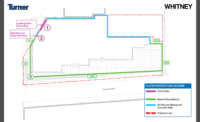Construction Science Fiction: Meeting of the Minds
It was going to be the press tour of a lifetime. Genevieve Taylor.53.Wong, the editor-in-chief of Engineering News-Record, stretched back in her office chair and tapped a few keys on the armrest. She was transferring all the background data she thought she would need on the trip into the implant in her temple, leaving messages for her editors, and checking on her zip car to JFK.
“Focus, Gen, focus,” she mumbled to herself. You could multitask yourself over the edge and leave a jumble in the database. A light in her headset blinked Incoming Call. She set the other tasks to continue on auto and tapped open the video line.
![]() It was the PR flack for Space Colony 2070—her very favorite person in the world after he included her in the junket to earth orbit to see the construction of the habitat that would carry 500 explorers light-years into space.
It was the PR flack for Space Colony 2070—her very favorite person in the world after he included her in the junket to earth orbit to see the construction of the habitat that would carry 500 explorers light-years into space.
“Gen, it’s Don.”
“I know, Don. What’s up? I’m getting ready to head out.”
“Did you remember to authorize the retinal scan and link to your e-passport?”
“Yes, Don. It was on the list. I was pretty careful about the list.”
“We’ll have a flight suit for you. Boots. Everything you need.”
He was annoying, but definitely her BFF of the moment. “Right, Don. I know. I’m not bringing anything but my implant and my Edit/Upload Suite—the audio, video and holographic recording and editing are built right into the goggles. They work with my implant, and I can transmit to our datacenter for broadcast.”
“We know we can count on you to stream the real technical accomplishments of this story, Gen. The mass holographers have gotten so caught up in the personal drama of the families who have been chosen for the voyage that the technological accomplishments are getting ignored.”
We’d been over all this before. “No worries, Don. ENR is definitely the place to tell the story of delivering this project. Talk about a remote site! I better go, Don. I’m getting picked up really soon. See you there.”
The car she had ordered was waiting when Gen got outside. She stepped in and tapped her implant against the doorplate to transfer the directions to the spaceport. She had been there before covering the major expansion of Cape Kennedy to outfit it for the fourth-gen fusion-powered space planes. She was just settling in when the call light blinked again. Not Don this time.
“Hi, Mom.”
“I know you told me not to worry, but I do worry. I’m your mother.”
“It’s OK, Mom. I did the training. I’m ready. Hundreds of workers have been making these runs for the past year. Construction is at its peak now. That’s why it’s a good time for an ENR story.”
“You’ll keep in touch?”
“Mom, I’m going up there to tell the story to engineers and contractors all over the world. Just tune in! Gotta go now … Bye … Love you!” She clicked out. That argument could go on and on, and she still had all the background she had uploaded to review on the trip … and then maybe a little nap. Didn’t get much sleep last night thinking about this excursion. She started reviewing. Hundred of exoplanets had been discovered by the 2010s. One found in 2013 that was more than 60 light-years away even had earth’s blue color, but 4,000-mph winds buffeted its silicate-laden air, and temperatures hovered around 1,000°C. The surprise didn’t come until 30-something years later, when Sagan was discovered—named for Carl Sagan because of role the SETI Institute played in first contact. The surprise was that the Saganites, as we called them (they called themselves something we had a hard time grasping), were just around the corner, astronomically speaking—just seven light-years away. Now they had a habitat heading our way, and we would soon be heading out to meet them. The contact launched the construction project of the century: Build a space habitat capable of supporting life and traveling two or three light-years—and put a rush on it!
The flight to Orlando was uneventful, and Don picked Gen up in a zip-pod for the ride to the spaceport. Gen never tired of seeing the Skylon 12G spaceplanes in their launchers. She got chills realizing she was actually going to be riding on one.
The next 24 hours went by so fast that Gen barely blinked—and included more time in lecture rooms and simulators than sleeping. Before she knew it, she was in a flight suit and helmet in the roaring U.S. SpacePlane Magellan with three other lucky tech-tellers, all strapped securely and feeling the often-described “gorilla on their chests,” until suddenly the engines shut down, and they were weightless. The Skylon maneuvered to match airlocks with the construction station and the guests stumbled inelegantly through the lock with some help from the crew. Gen immediately bonded with the tech-tellers from IEEE Spectrum and Civil Engineering, whom she knew from other events. But all three got an odd vibe from the fourth guest from OtherWorld, a platform for data about the exoplanets and potential inhabitants.
What he was doing on the trip became clear in the first interview with the program manager in a small meeting room with the jurnos tethered around a viewport overlooking the habitat construction. They were all exhausted but could not drag their eyes away from the ungainly structure taking shape against the backdrop of earth—except for Al, that is, who seemed strangely disengaged.
Gen was struggling to ignore a queasy spacesick feeling as she held on, tried to keep still, operated her recording devices and asked about the three angles to the story that she saw: engineering, construction methods, and systems and receptivity, when “OtherWorld Al” suddenly interrupted. “I’m here to help you interpret what the Saganites will make of this structure.” he blurted out. “Will it look threatening or beautiful? But why bring me in now when you are already so far along?”
Ha! Consultants have been saying that about construction projects for centuries, Gen thought. Al left abruptly, went back to the bunkroom and netted in, leaving the others surprised but more occupied with the briefing than with Al’s outburst.
Gen blinked sleepy eyes and tried to concentrate. Supply chain from both Earth and Moon base. Metal shapes extruded in orbit. Composites. Modules. Hydroponics. Crew of 20 professionals and craft workers guiding and servicing the construction-assembly robots. Gen was streaming the story as fast as the PM pitched it. She added a few notes to her editors in Mumbai, Rio and London. They could tweak the streams a bit and put the story out as a breaking news flash.
Finally, they ate and netted in. Exhilarated but exhausted, Gen closed her eyes and quickly dropped to sleep. The next day was the main event. The four visitors paired off to ride two-passenger inspection craft on a tour around the outside of the massive habitat. The small automated shuttlecraft could be used with or without passengers to perform routine checks and video capture of the construction under way. Gen was not at all pleased to be paired with Al, but she didn’t want to be Ms. Complainy Pants, so they both suited up and strapped in.
As they took off, Gen was all business, recording and streaming everything she could see. It was amazing and dramatic: an enormous structure and future vehicle/home for 500 souls for seven years … or more? As they swung around the colony and saw it framed against earth, she caught sight of Al sitting—or shrinking—into his seat and decidedly shimmering.
“Al, are you all right?” she asked. He didn’t look all right.
“I’m having trouble,” he said.
“What trouble? Do you want me to get help?” Gen was about to open a channel in her goggles back to the station.
“No! Don’t! I’m OK.” Al was definitely transforming. How weird—it almost looked like his face was morphing. In fact, his face was definitely morphing, and so were his hands. He looked somewhat gelatinous. His voice was different, too, deep and rumbling.
“I just can’t hold up the humanoid projection up here. Don’t be afraid. I’m what you humans call a Saganite.”
Gen was stunned and silent, having trouble believing what she was seeing. She forgot the amazing construction drama outside the shuttle for the even more amazing life form emerging inside.
“The authorities know. Three of us—explorers—came here and helped your astronomers find our planet. It’s been kept quiet. We all thought it would be more acceptable if official delegations met each other half way. I needed to experience the habitat at close range, so they cooked up this press tour to get me up here without causing a stir. Will you help me? Keep this between us and not put it in your story?”
A hundred possibilities raced through Gen’s mind. This could be the story of a lifetime, but something about this vulnerable alien made her want to help him, and she realized that she still had the story of a lifetime.
“No worries,” she told Al. “I’m after the construction story.” Gen flicked on the video line in her goggles and turned her attention back to the silent ballet of equipment assembling the habitat against the backdrop of earth and stars.

Janice L. Tuchman directs the editorial operations of the ENR enterprise—online, in print and at live events. She has loved science fiction since she was 10 years old and is thrilled to bring stories about the future of construction to ENR readers. While she also was a judge of the competition, she wants everyone to know she recused herself from judging or editing her own story!
To see all of the stories in ENR's Imagining Construction's Future science fiction collection, click here.







